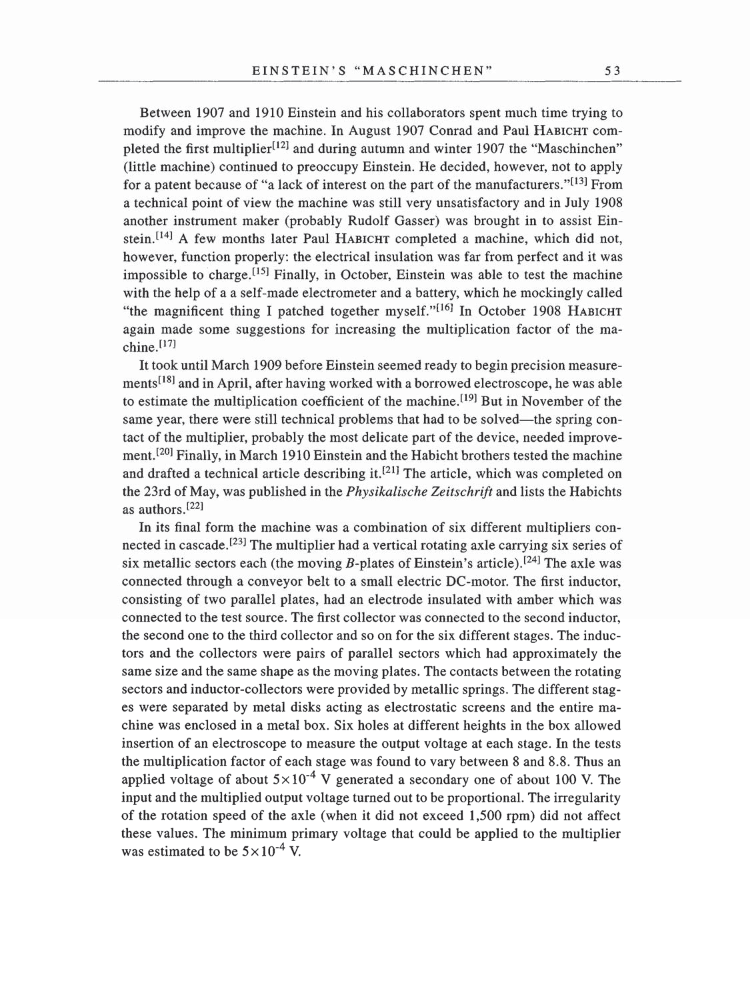EINSTEIN'S "MASCHINCHEN" 53 Between 1907 and 1910 Einstein and his collaborators spent much time trying to modify and improve the machine. In August 1907 Conrad and Paul Habicht com- pleted the first multiplier[12] and during autumn and winter 1907 the "Maschinchen" (little machine) continued to preoccupy Einstein. He decided, however, not to apply for a patent because of "a lack of interest on the part of the manufacturers."[13] From a technical point of view the machine was still very unsatisfactory and in July 1908 another instrument maker (probably Rudolf Gasser) was brought in to assist Ein- stein.[14] A few months later Paul Habicht completed a machine, which did not, however, function properly: the electrical insulation was far from perfect and it was impossible to charge.[15] Finally, in October, Einstein was able to test the machine with the help of a a self-made electrometer and a battery, which he mockingly called "the magnificent thing I patched together myself."[16] In October 1908 Habicht again made some suggestions for increasing the multiplication factor of the ma- chine.[17] It took until March 1909 before Einstein seemed ready to begin precision measure- ments[18] and in April, after having worked with a borrowed electroscope, he was able to estimate the multiplication coefficient of the machine.[19] But in November of the same year, there were still technical problems that had to be solved-the spring con- tact of the multiplier, probably the most delicate part of the device, needed improve- ment.[20] Finally, in March 1910 Einstein and the Habicht brothers tested the machine and drafted a technical article describing it.[21] The article, which was completed on the 23rd of May, was published in the Physikalische Zeitschrift and lists the Habichts as authors.[22] In its final form the machine was a combination of six different multipliers con- nected in cascade.[23] The multiplier had a vertical rotating axle carrying six series of six metallic sectors each (the moving B-plates of Einstein's article).[24] The axle was connected through a conveyor belt to a small electric DC-motor. The first inductor, consisting of two parallel plates, had an electrode insulated with amber which was connected to the test source. The first collector was connected to the second inductor, the second one to the third collector and so on for the six different stages. The induc- tors and the collectors were pairs of parallel sectors which had approximately the same size and the same shape as the moving plates. The contacts between the rotating sectors and inductor-collectors were provided by metallic springs. The different stag- es were separated by metal disks acting as electrostatic screens and the entire ma- chine was enclosed in a metal box. Six holes at different heights in the box allowed insertion of an electroscope to measure the output voltage at each stage. In the tests the multiplication factor of each stage was found to vary between 8 and 8.8. Thus an applied voltage of about 5xl0-4 V generated a secondary one of about 100 V. The input and the multiplied output voltage turned out to be proportional. The irregularity of the rotation speed of the axle (when it did not exceed 1,500 rpm) did not affect these values. The minimum primary voltage that could be applied to the multiplier was estimated to be 5 x 10-4 V.
